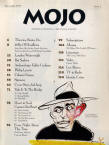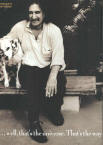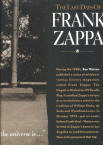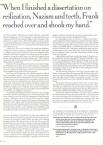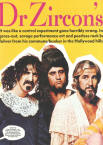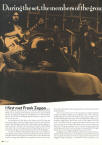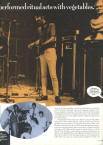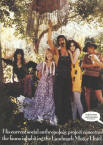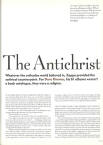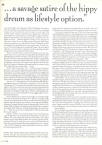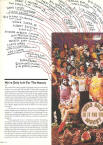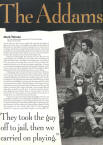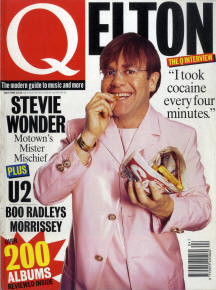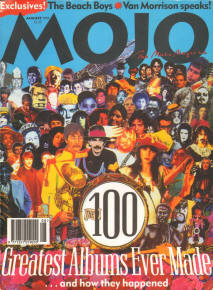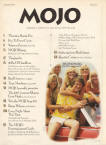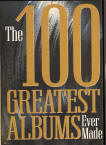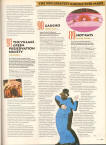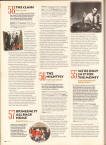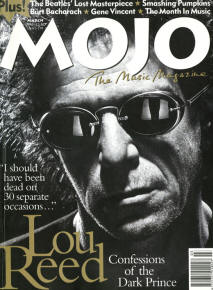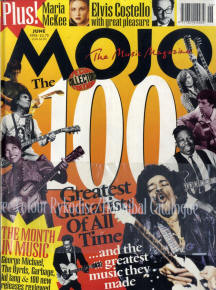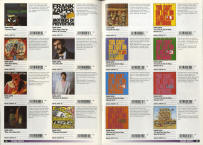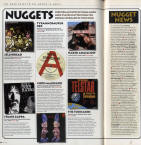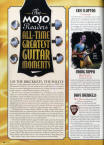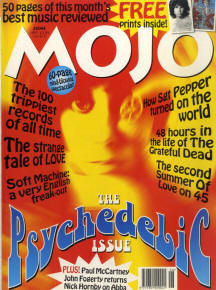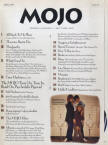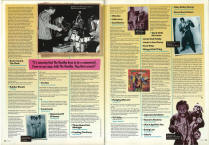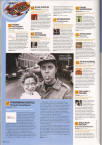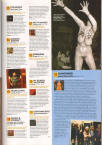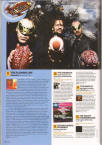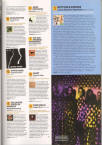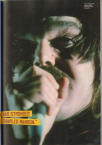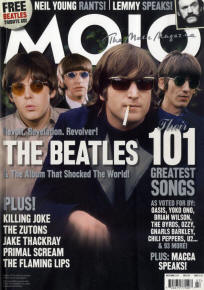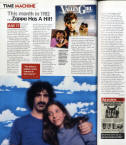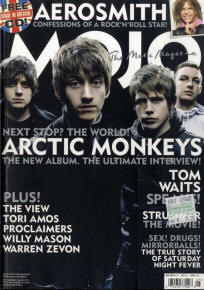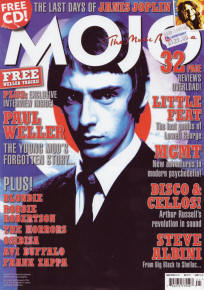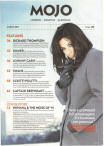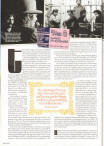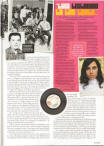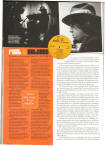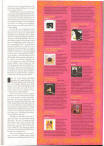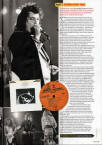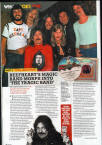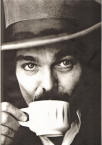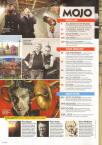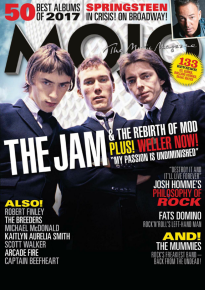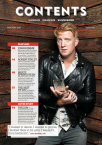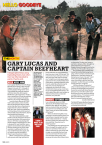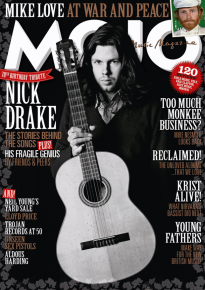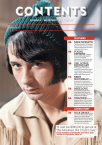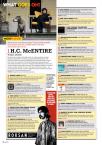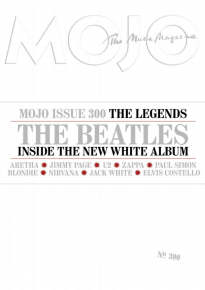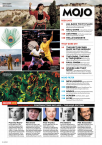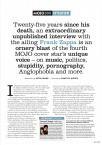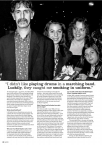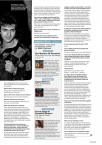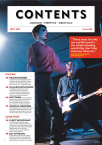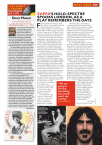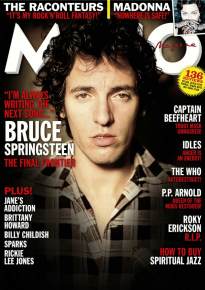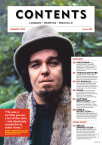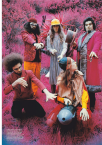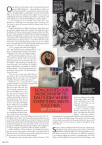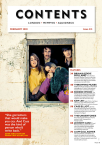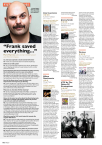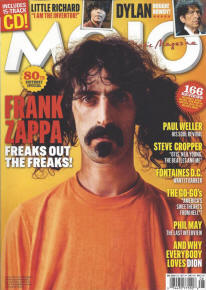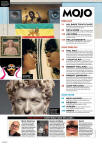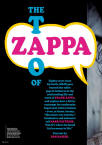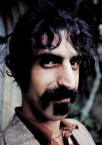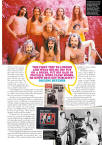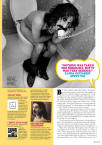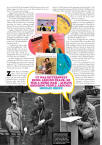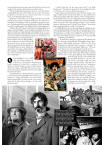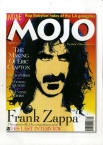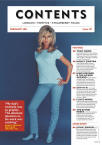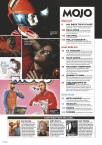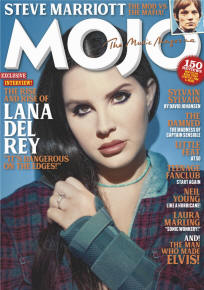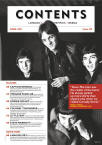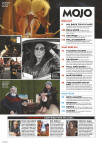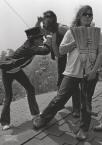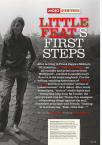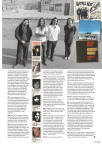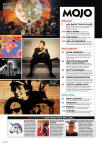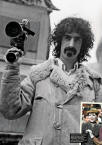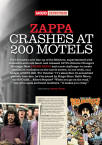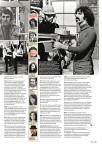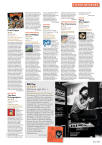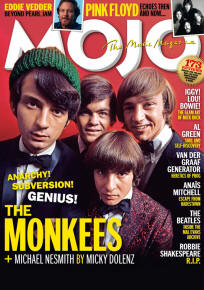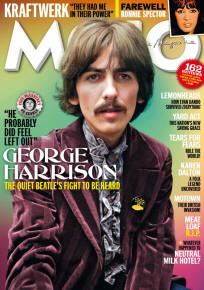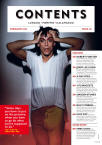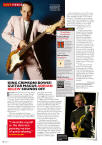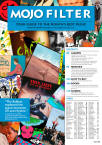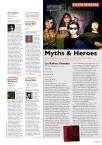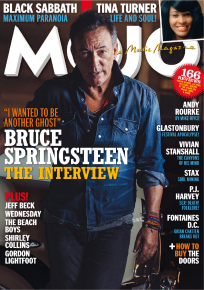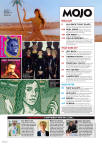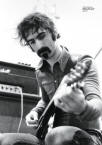Mojo
See also Mojo Collections and Mojo Specials.
When Captain Beefheart recorded his vocal for Zappas Willie The Pimp at the Hot Rats sessions, Miles was there. (read more)
Source: Fulvio Fiore
 HAVING,
IT SEEMS, PLAYED HIS last guitar solo, Frank Zappa has retuned
to his initial goal: making his mark as a classical composer.
After lacklustre LSO sessions and stiffnecked renditions by
Pierre Boulez, he has now found musicians who sound like they
were born to tackle his complex, modernistic miniatures with
fluency and finesse. (read
more)
HAVING,
IT SEEMS, PLAYED HIS last guitar solo, Frank Zappa has retuned
to his initial goal: making his mark as a classical composer.
After lacklustre LSO sessions and stiffnecked renditions by
Pierre Boulez, he has now found musicians who sound like they
were born to tackle his complex, modernistic miniatures with
fluency and finesse. (read
more)
Source: Fulvio Fiore
1994 March
No. 4
The Last Days Of Frank
Zappa
By Ben Watson, pp 72-76
Dr. Zircon's Secret Lab
By Miles, pp 78-88
The Antichrist
By Dave Rimmer, pp 90-93
The Grand Wazoo
Cal Schenkel interview by Miles, pp 93-95
The Addams Family
Mark Volman, Elliott Ingber, Arthur Barrow, Essra Mohawk, Ian
Underwood, Art Tripp interviews by Dave Dimartino, pp 96-98
The Last Days Of Frank Zappa:
It’s rare that any musicians who’ve worked with you do any better when they’re out on their own. If your musicians solo they do so at the peek of their intensity - how do you stop them coasting? Is it a matter of giving them instructions, or just the challenge of the musical environment they’re given?
I don’t understand the question.
Your musicians always play – it seems to me – at the peak of what they’re capable of doing. One of the things I really like about your records is that if there’s a solo people don’t noodle, they don’t coast – they really play hard.
Yeah.
Is that because of whet you tell them before they play? Or is it simply the challenge of the music?
The reason is that I tell them before they ploy and because all the live stuff is edited, so l look for the best work that each musician can do, It’s not just a matter of cloying something together, I try and make the performance of each tune exemplary in some way. So I’m not just optimising what I write, I’m optimising what they improvise. (read more)
Source: zappateers
Completed shortly before his death, this 2 CD
"opera pantomime" is a combination of Zappa's orchestral dabblings
– this time performed by The Ensemble Modern – and a largely
improvised script (some of which is taken from the 1967 Lumpy
Gravy sessions) involving the adventures of people (hippies,
frankly) who inhabit a piano, this particular concept having
come from the idea that the actors talked into a miked-up piano
while Frank suggested conversational topics ("pigs, ponies,
dark water ...") from the control room. Roundly unhilarious
in its execution (unless you happen to be as stoned as the participants),
the erratically complex musical arrangements begin to set the
listener's teeth fully into grind mode, making Zappa's last
album (although it's rumoured he completed others before his
death) a trying affair for everyone except strongly devoted
completists. ★


Source: Fulvio Fiore
1995 July
No. 20
A scabrous disembowelling
of the hippy dream (Review of 6 albums)
By John Bungey, p 102
1995 November
No. 24
Frank Zappa: Strictly Commercial - The Best Of Frank
Zappa
By Martin Gordon, p 123

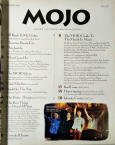 AFTER
THE ONSLAUGHT of Rykodisc’s complete remastered Zappa catalogue
comes a mail order item “for all of Frank’s fans”, compiled
by his son Dweezil. Six of its seven tracks consist of previously
unissued live performances and the studio versions ofwhat Frank
regarded as his “signature pieces” – those that best displayed
his abilities as guitarist and composer. They are: Black Napkins,
Zoot Allures and the majestic Watermelon In Easter Hay. Live
versions predating their studio realisation have been deliberately
chosen to show the creative distance each travelled before achieving
Frank‘s approval. The ‘bonus track’, Merely A Blues In A, is
a concert encore that repays a debt to Johnny ‘Guitar’ Watson.
AFTER
THE ONSLAUGHT of Rykodisc’s complete remastered Zappa catalogue
comes a mail order item “for all of Frank’s fans”, compiled
by his son Dweezil. Six of its seven tracks consist of previously
unissued live performances and the studio versions ofwhat Frank
regarded as his “signature pieces” – those that best displayed
his abilities as guitarist and composer. They are: Black Napkins,
Zoot Allures and the majestic Watermelon In Easter Hay. Live
versions predating their studio realisation have been deliberately
chosen to show the creative distance each travelled before achieving
Frank‘s approval. The ‘bonus track’, Merely A Blues In A, is
a concert encore that repays a debt to Johnny ‘Guitar’ Watson.
Source: Fulvio Fiore
In November 1967, a bunch of freaks purchased KPPC in
Source: slime.oofytv.set
It’s 1968, at the Laurel Canyon Country Store in the Hollywood hills. Drummer Ansley Dunbar meets a 15-year-old hippie chick named Pattie and asks if she wants to go to a party at Frank Zappa's house. (read more)
2004 January
No. 122
12-page tribute:The Father Of Invention
By Charles Shaar Murray, pp 46-50
The Many Faces Of Frank Zappa
The best of FZ's 50-plus albums.
By Charles Shaar Murray, p 49
Shhhh ... Genius At Work
By Sylvie Simmons, pp 50-51
The Last Post
Interview by Phil Alexander, pp 52-55
Keeper Of The
Flame
Gail Zappa interview by Phil Alexander, pp 55
The Last Post:
Let’s move on. You seem to be moving away from music
and into the world of politics and finance. How do you view
the business world?
“Hmmm... I think business is a good thing. Generals could learn
a lot from corporate executives. The first rule is, you don’t
kill your customers. If there is going to be a World War III
then the major weapon is going to be the cash register and not
nuclear missiles. People have to think about the business. They
have to. I’ve never been shy about saying I was a businessman,
even in the ‘60s. It was the last thing in the world that anybody
would want to say. I prefer to be able to earn money from what
I do rather than take a part-time job in order to afford the
pleasure of being a musician. I would rather scale my operation
to a size where it can finance itself. And I think that today
that there are a lot of people in rock’n’roll who are getting
that idea. It’s not bad to look after your own interest.” (read
more)
As a teenager John Frusciante made tapes of Zappa's guitar solos and learnt the lot. He also compiled a CD of his fave FZ moments for Rykodisc which has yet to be released. The story of his audition for Frank's band can be found on page 74. Meanwhile here, the nine-minute Son Of Mr Green Genes sees Zappa extending himself into jazz rock territory to fine and fearsome fusionistic effect.
Pimp My Ride
ZAPPA, JOHNNY CASH, PINK FLOYD
AND MORE STAR IN THE ROCK PHOTOGRAPHY OF BARON WOLMAN. BY
CLIVE PRIOR
AT THE time we were working, we were pretty much alone in the profession," muses Baron Wolman, who between 1967-70 was the main photographer for Rolling Stone magazine. "Now the field is flooded with shooters and their images, the profession is less honoured, and the fun is gone."
Next month a new Wolman exhibition at London's Blink Gallery aims to recall those times. Photos of Jimi Hendrix, Pink Floyd, Johnny Cash, Janis Joplin, Sun Ra, Mick Jagger, Joni Mitchcll, B.B. King and more will be seen, as will this impromptu shot of Frank Zappa messing about on a bulldozer: "We had complete access," adds Wolman, who is president of photography publishers Squarebooks. "We could go backstage, we could go on-stage – in the wings, of course – we could go right up to the front of the stage!"
Another salute to Zappa comes in the form the bottled beer, Lagunitas Freak Out! Ale. Its label is the cover of the 1966 Freak Out!. SoCal bewers Lagunitas will mark other Zappa LP anniversaries with Absolutely Free, Lumpy Gravy and Hot Rats ales.
Behind the CAMERA
Frank Zappa on a bulldozer, Laurel Canyon, Los Angeles, from
the cover shoot of the May 1968 Rolling Stone. By Baron Wolman.
Baron Wolman: "Up the hill and behind Zappa's rented house,
there was this collection of rusty earth-moving equipment. We
just walked over to the machines and he started goofing around
and I started shooting photos. It was one of those wonderfully
spontaneous photo moments, relaxed and informal and fun –
his 'outside the box' behaviour was infectious. We took pictures
for about half an hour, before the interview, which was rare.
Seldom did I have the subject alone for so long in advance of
the sit-down. Though truthfully, his music was pretty much an
unknown to me."
I was working with my trio with [violinist] Jean-Luc Ponty in a small rock club in Los Angeles called Thee Experience on Sunset Boulevard, and Frank Zappa came in. (read more)
"The passing of Captain Beefheart on December 17, 2010, robbed music of one of its most unique, mischievous and singular voice. MOJO's 10-page tribute sees his biographer Mike Barnes speak to his associates and salute the man and his myth. Elsewhere. Mark Paytress assesses his key recordings (page 69), P.J. Harvey discusses his impact and friendship (page 67), David Fricke remembers his many encounters with the man (page 68) and Jack White III provides his own epitaph (page 73), as we bid farewell to the artist born Don Van Vliet ..."
Andrew Male speaks to Art Kane's son, Jonathan, about the vision and invention of a great American artist.
Jonathan Kane: "This is possibly my favourite of all images from LIFE Magazine's 'The New Rock' essay, it's so full of life, love and humour. I was there, at age 11, arriving just after the shooting wrapped. Frank Zappa met me at the door of dad's studio with a hug and said, 'Hey man, you should have been here an hour ago, the babies were pissing all over us, we got soaked man!' Twenty-five years later I was playing on a bill with Mothers Of Invention drummer Jimmy Carl Black. At the soundcheck I told Jimmy how Zappa and the band were all so nice to me as a young kid. He replied: 'Why do you think they called us The Mothers, man?'"
In this issue Frank Zappa was mentioned several times:
- p 9, Ian Anderson declares, that his all-time favourite album is Over-Nite Sensation,
- p 18, Pink Floyd and Frank Zappa at Amougies Festival, 1969, are included into playlist,
- pp 40, 41, Mike Nesmith in his interviews mentions Frank Zappa,
- p 50, picture of Frank Zappa and Captain Beefheart, as a part of article on photographer Alec Byrne.
2019 May
No. 306
Zappa's Holo-spectre Spooks London,
As A Play Remembers The Days
By Alan Clayson, p 21
Large format (double A4) wall calendar. Illustrated with 12 covers (one per month) of selected Mojo back issues. March month cover - March 1994 with Frank Zappa.
Source: Fulvio Fiore
2021 April
No. 329
Little Feat's First Steps
Interviews by Bob Mehr, Portrait by Susan Titelman, pp 52-55
Page 39, article on Deep Purple:
Whatever happened to Zdenek Spicka? Deep Purple don't know,
even though he helped inspire their greatest hit. On December
4, 1971, Spicka, a 21-year-old Czech living in Switzerland,
attended a Frank Zappa And The Mothers Of Invention show at
the Montreux Casino. Spicka was carrying a flare gun of the
kind used to signal distress at sea. During Zappa's song King
Kong, Spicka fired the weapon in the air. Its flare ignited
the ceiling tiles, setting the whole wooden building ablaze.
"It was a raging inferno," remembers eyewitness and Deep Purple
vocalist Ian Gillan. Luckily, Zappa, his Mothers and the audience
escaped death or serious injury. A warrant was issued for Spicka's
arrest, but he fled Switzerland and was never found.
Frank Zappa is also namechecked on page 122 in article on Grand Funk Railroad.
50th anniversary box-set celebration of Zappa’s jazzer-most period. In December 1971 Frank Zappa was pushed off stage by a fan at London’s Rainbow Theatre, landing in the orchestra pit 10-feet below, left unconscious and with a broken leg. Convalescing back in LA, he wheeled himself into Paramount Studios for sessions that would yield two crucial albums, Waka/Jawaka (his intended sequel to 1969’s Hot Rats) and epic Miles-inspired fusion The Grand Wazoo. Both LPs are remastered from original tapes and are included here in Blu-Ray audio with Atmos and 5.1 options, along with 30 unreleased tracks presented in chronological order across a further four CDs. Two discs provide moments of real revelation and unbridled intoxication: the first features keyboard player George Duke’s super-soulful demos/alt-takes recorded in parallel at Paramount (FZ produces and plays guitar), the second contains the final bow of Zappa’s Petite Wazoo band at San Francisco’s Winterland Ballroom in December ’72. Awreetus-awrightus, as the man himself would say.
On page 20 is Adrian Belew featured.
2023 August
No. 357
Shake your tail (Funky
Nothingness)
By Mark Paytress, pp 90-91
Happy Forever (A
book by Mark Volman)
By Mark Paytress, p 105

